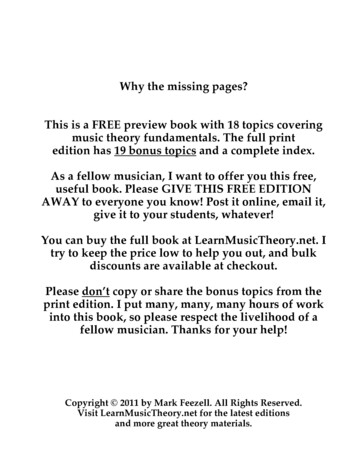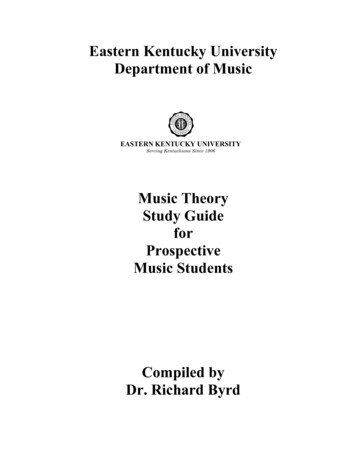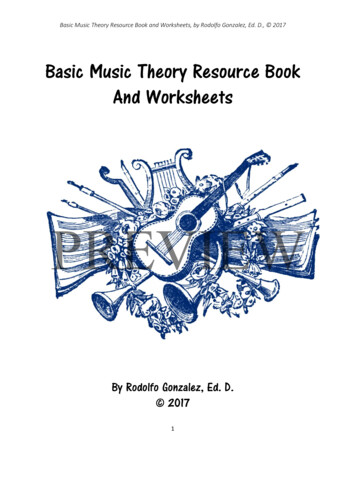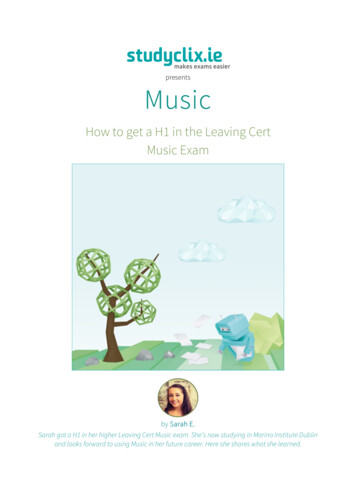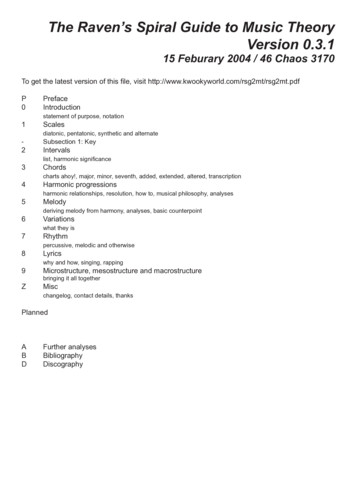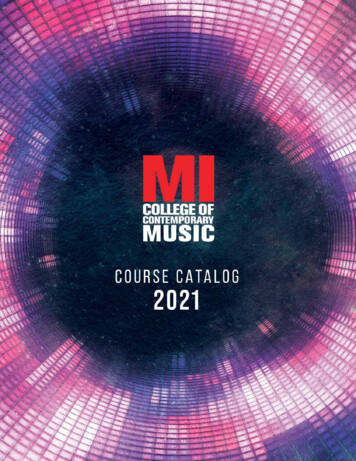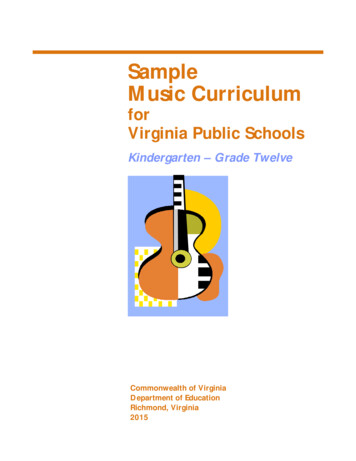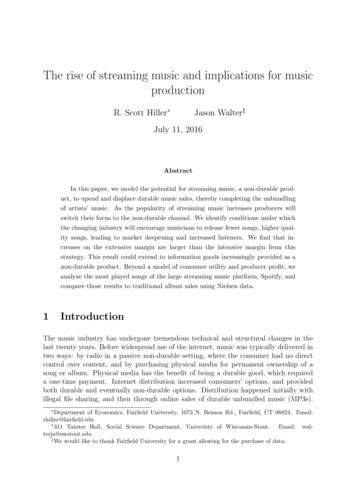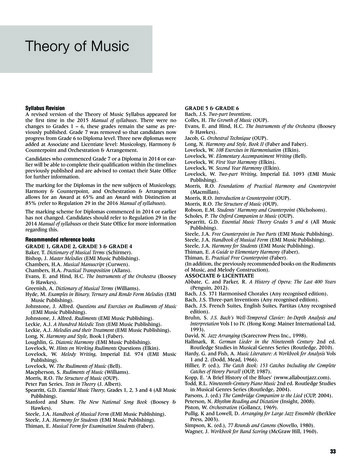
Transcription
Theory of MusicSyllabus RevisionA revised version of the Theory of Music Syllabus appeared forthe first time in the 2015 Manual of syllabuses. There were nochanges to Grades 1 – 6, these grades remain the same as previously published. Grade 7 was removed so that candidates nowprogress from Grade 6 to Diploma level. Three new diplomas wereadded at Associate and Licentiate level: Musicology, Harmony &Counterpoint and Orchestration & Arrangement.Candidates who commenced Grade 7 or a Diploma in 2014 or earlier will be able to complete their qualification within the timelinespreviously published and are advised to contact their State Officefor further information.The marking for the Diplomas in the new subjects of Musicology,Harmony & Counterpoint, and Orchestration & Arrangementallows for an Award at 65% and an Award with Distinction at85% (refer to Regulation 29 in the 2016 Manual of syllabuses).The marking scheme for Diplomas commenced in 2014 or earlierhas not changed. Candidates should refer to Regulation 29 in the2014 Manual of syllabuses or their State Office for more informationregarding this.Recommended reference booksGRADE 1, GRADE 2, GRADE 3 & GRADE 4Baker, T. Dictionary of Musical Terms (Schirmer).Bishop, J. Master Melodies (EMI Music Publishing).Chambers, H.A. Musical Manuscript (Curwen).Chambers, H.A. Practical Transposition (Allans).Evans, E. and Hind, H.C. The Instruments of the Orchestra (Boosey& Hawkes).Greenish, A. Dictionary of Musical Terms (Williams).Hyde, M. Examples in Binary, Ternary and Rondo Form Melodies (EMIMusic Publishing).Johnstone, J. Alfred. Questions and Exercises on Rudiments of Music(EMI Music Publishing).Johnstone, J. Alfred. Rudiments (EMI Music Publishing).Leckie, A.J. A Hundred Melodic Tests (EMI Music Publishing).Leckie, A.J. Melodies and their Treatment (EMI Music Publishing).Long, N. Harmony and Style, Book l (Faber).Loughlin, G. Diatonic Harmony (EMI Music Publishing).Lovelock, W. Hints on Working Rudiments Questions (Elkin).Lovelock, W. Melody Writing, Imperial Ed. 974 (EMI MusicPublishing).Lovelock, W. The Rudiments of Music (Bell).Macpherson, S. Rudiments of Music (Williams).Morris, R.O. The Structure of Music (OUP).Peter Pan Series. Tests in Theory (J. Albert).Spearritt, G.D. Essential Music Theory, Grades 1, 2, 3 and 4 (All MusicPublishing).Stanford and Shaw. The New National Song Book (Boosey &Hawkes).Steele, J.A. Handbook of Musical Form (EMI Music Publishing).Steele, J.A. Harmony for Students (EMI Music Publishing).Thiman, E. Musical Form for Examination Students (Faber).GRADE 5 & GRADE 6Bach, J.S. Two-part Inventions.Colles, H. The Growth of Music (OUP).Evans, E. and Hind, H.C. The Instruments of the Orchestra (Boosey& Hawkes).Jacob, G. Orchestral Technique (OUP).Long, N. Harmony and Style, Book II (Faber and Faber).Lovelock, W. 108 Exercises in Harmonisation (Elkin).Lovelock, W. Elementary Accompaniment Writing (Bell).Lovelock, W. First Year Harmony (Elkin).Lovelock, W. Second Year Harmony (Elkin).Lovelock, W. Two-part Writing, Imperial Ed. 1093 (EMI MusicPublishing).Morris, R.O. Foundations of Practical Harmony and Counterpoint(Macmillan).Morris, R.O. Introduction to Counterpoint (OUP).Morris, R.O. The Structure of Music (OUP).Robson, E.M. Students’ Harmony and Counterpoint (Nicholsons).Scholes, P. The Oxford Companion to Music (OUP).Spearritt, G.D. Essential Music Theory Grades 5 and 6 (All MusicPublishing).Steele, J.A. Free Counterpoint in Two Parts (EMI Music Publishing).Steele, J.A. Handbook of Musical Form (EMI Music Publishing).Steele, J.A. Harmony for Students (EMI Music Publishing).Thiman, E. A Guide to Elementary Harmony (Faber).Thiman, E. Practical Free Counterpoint (Faber).(In addition, the previously recommended books on the Rudimentsof Music, and Melody Construction).ASSOCIATE & LICENTIATEAbbate, C. and Parker, R. A History of Opera: The Last 400 Years(Penguin, 2012).Bach, J.S. 371 Harmonised Chorales (Any recognised edition).Bach, J.S. Three-part Inventions (Any recognised edition).Bach, J.S. French Suites, English Suites, Partitas (Any recognisededition).Bruhn, S. J.S. Bach’s Well-Tempered Clavier: In-Depth Analysis andInterpretation Vols I to IV. (Hong Kong: Mainer International Ltd,1993).David, N. Jazz Arranging (Scarecrow Press Inc., 1998).Hallmark, R. German Lieder in the Nineteenth Century 2nd ed.Routledge Studies in Musical Genres Series (Routledge, 2010).Hardy, G. and Fish, A. Music Literature: A Workbook for Analysis Vols1 and 2. (Dodd, Mead, 1966).Hillier, P. (ed.), The Catch Book: 153 Catches Including the CompleteCatches of Henry Purcell (OUP, 1987).Kopp, E. ‘A Brief History of the Blues’ (www.allaboutjazz.com).Todd, R.L. Nineteenth-Century Piano Music 2nd ed. Routledge Studiesin Musical Genres Series (Routledge, 2004).Parsons, J. (ed.) The Cambridge Companion to the Lied (CUP, 2004).Peterson, N. Rhythm Reading and Dictation (Insight, 2008).Piston, W. Orchestration (Gollancz, 1969).Pullig, K and Lowell, D. Arranging for Large Jazz Ensemble (BerkleePress, 2003).Simpson, K. (ed.), 77 Rounds and Canons (Novello, 1980).Wagner, J. Workbook for Band Scoring (McGraw Hill, 1960).33
New AMEB Online Exam CentreAvailable 1st January 2018TakMu e youor Msic, M r Theoonl usic usici ry ofaexa ine at Craft nshimsexa p.ammeb.edu.au.exams.ameb.edu.auThe following is a list of terms required in the grades. Themeanings given are those which the Board considers to besatisfactory English equivalents.Terms required for Grade 1SPEEDAdagio, slowly.Andante, at an easy walking pace.Moderato, at a moderate speed.Allegro, lively and fast.Presto, very fast.MODIFICATIONS OF SPEEDAccelerando (accel.), gradually becoming faster.Rallentando (rall.), gradually becoming slower.Ritardando (ritard.) (rit.), gradually becoming slower.Ritenuto (riten.) (rit.), immediately slower, or held back.A tempo, return to former speed.INTENSITY OF SOUNDCrescendo (cres.) (cresc.), gradually becoming louder.Decrescendo (decres.) (decresc.), gradually becoming softer.Diminuendo (dim.), gradually becoming softer.Forte (f), loud.Piano (p), soft.OTHER TERMSLegato, smoothly, well connected.Staccato, detached, short.Additional Terms for Grade 2SPEEDLento, slowly.Largo, broadly.Allegretto, moderately fast.Vivace, lively, spirited.Vivo, lively, spirited.34MODIFICATIONS OF SPEEDAllargando, becoming broader.Più mosso, quicker.Meno mosso, slower.INTENSITY OF SOUNDPianissimo (pp), very soft.Fortissimo (ff), very loud.Mezzo forte (F), moderately loud.Mezzo piano (P), moderately soft.OTHER TERMSMaestoso, majestic.Sostenuto, sustained.Sempre, always.Poco, a little.Molto, very.Senza, without.Cantabile, in a singing style.Leggiero, lightly.Dal segno, from the sign.Da capo al fine, from the beginning to the word fine.Mezzo staccato, moderately short and detached.Additional Terms for Grade 3SPEEDLargamente, broadly.Larghetto, rather broadly.Prestissimo, extremely fast, or as fast as possible.Con moto, with movement.INTENSITY OF SOUNDCalando, getting softer and slower.Morendo, dying away.Forte-piano (fp), loud then immediately soft.Sforzando (sf) (sfz), a strong accent.
Theory Theory of Musicgrades 1 & 2Keys and Scales(i) The recognition and writing of the scales of C, G and F majorover one octave only; their key signatures; and the positioningof their tones and semitones.(ii) The writing of scale degree numbers under the notes of a tune.OTHER TERMSAgitato, with agitation.Attacca, go on at once.Animato, with animation.Tranquillo, calmly.Con anima, with feeling.Con brio, with spirit.Con grazia, with grace.Con forza, with force.Dolce, soft and sweet.Risoluto, with resolution.Ben marcato, well marked.Main droite (M.D.), right hand.Main gauche (M.G.), left hand.Una corda, with the soft pedal.Tre corde, release the soft pedal.Ad libitum, at pleasure, quite freely.Opus, a work or group of works.Loco, at normal pitch (after ansign).IntervalsRecognition and writing of all diatonic intervals above the tonicin the keys specified for the grade, in the treble clef (by numberonly, not q uality).ChordsWriting the tonic triad in root position in the keys specified for thegrade, in the treble clef.Time and RhythmThe following note values and rests:Additional Terms for Grade 4SPEEDTempo commodo, at a comfortable speed.Tempo giusto, at a consistent speed.L’istesso tempo, at the same speed.Non troppo, not too much.Grave, slow and solemn.MODIFICATIONS OF SPEEDRubato, with some freedom in the time.Stringendo, pressing on faster.INTENSITY OF SOUNDPerdendosi, fading away.Smorzando, dying away.Rinforzando, (rfz),(rf) reinforcing the tone.Pesante, heavily.OTHER TERMSCantando, in a singing style.Tenuto, (ten.) held.Piacevole, pleasant, agreeable.Portamento, a smooth gliding from one note to another (as in singing or string playing).Dolente, sadly, plaintively.Doloroso, sadly, plaintively.Sotto voce, softly in an undertone.Giocoso, gay, merry.Grazioso, gracefully.Assai, very.Quasi, as if, as it were.Scherzando, playfully.Subito, (sub.) suddenly.TERMS REFERRING TO STRING PLAYINGSul ponticello, (sul. pont.) bow on or near the bridge.Sul tasto, bow on or near the finger board.Tremolo, bowing very rapidly (usually on one note at a time), toproduce a shimmering or wavering effect.Pizzicato, (pizz.) pluck the string with the finger (instead of bowingit).Arco, with the bow (used after a pizz. sign).GRADE 1œ œ œ Ó Œw . 0001The paper may comprise questions on:Pitch and TonalityThe treble and bass clefs, the names of the lines and spaces, including two leger lines above and below each stave. The sharp, flat andnatural.234The following time signatures 4, 4, 4,(c) with or without one beatbefore the first bar-line (anacrusis).jjTranspositionœ œ œ , œ. œ , œwillœ œ œbe, œ œ œ œ, œ , ‰Candidatesgiven a short melody without accidentals andnot more than four bars in length, which they will be asked totranspose into one of the required keys for this grade. Note valueswill be those specified for the grade.3j‰œ œ œ , œ œ , œ. , . ,TerminologyThe English meanings of the following terms, together with theirabbreviations and signs where applicable.SPEEDAdagio, andante, moderato, allegro, presto.MODIFICATIONS OF SPEEDAccelerando, rallentando, ritardando, ritenuto, a tempo.INTENSITY OF SOUNDCrescendo, decrescendo, diminuendo, forte, piano.OTHER TERMS RELATING TO PERFORMANCELegato, staccato.SIGNSTie, slur, bar line, double-bar line.GRADE 20002Questions on:Pitch and TonalityKeys and ScalesThe recognition and writing of scales and their key signatures asfor Grade 1, with the addition of D and A major, and of A, E, andD minor (harmonic form), through one or two octaves; includingthe positioning of their tones and semitones.IntervalsRecognition and writing of all diatonic intervals above the tonic inthe keys specified for the grade, in the treble clef (both quality andnumerical value required).w . œ œ œ Ó ŒChordsWriting the tonic triad in root position in the keys specified for thegrade,Ó Œclef.w . in the trebleœ œ orœ bass3Timeandjj RhythmœToœtheœ , œ.note-valuesœ , œ œ œ œ , œandœ œ œ ,restsœ , ‰ in the previous grade add:3jjœ œ œ , œ. œ , œ œ œ œ , œ œ œ œ , œ , ‰ in simple time;jœ œ œ , œ œ , œ. , . , ‰ in compound time;jœ œ œ , œ œ , œ. , . , ‰35
Theory Theory of Musicgrades 3 & 4jjœ as an anacrusis before the bar line. The semibreveœ as it occurs (or whole bar) rest is to be added:Time and RhythmTo the note values and rests in the previous grades add:6j̊ j̊To the time signatures of the previous grade, add 8 with or without œ œ œ , œœœœ , œ 2, œœ, œ , Œœ ., (Œ‰.), ,(‰.), , ‰ ., œ , œœœ, œ.œ , œœ., œ.œœ , œ.œ2anacrusis.TranspositionCandidates will be given a short melody in one of the keys andinvolving note values specified for this grade, and not more thaneight bars in length, which they will be asked to transpose intoanother of the required keys for the grade. Only accidentalsinvolving the leading note of the minor key will be introduced.3 239To the time signatures of the previous grades add: 2, 2, C, 8, 8TranspositionCandidates will be given a short melody involving note valuesspecified for this grade, and not more than eight bars in lengthwhich they will be asked to transpose into one of the requiredkeys for the grade. Simple accidentals may be involved.TerminologyIn addition to the terms set for the previous grade, the Englishmeanings of the following terms, together with their abbreviationsand signs where applicable.SPEEDLento, largo, allegretto, vivace, vivo.MODIFICATIONS OF SPEEDAllargando, più mosso, meno mossoINTENSITY OF SOUNDPianissimo, fortissimo, mezzo forte, mezzo piano.OTHER TERMS RELATING TO PERFORMANCEMaestoso, sostenuto, sempre, poco, molto, senza, cantabile, leggiero, dalsegno, da capo al fine, mezzo staccato.SIGNSAs required for Grade 1 with the addition of the pause, repeat signand signs for accent.TerminologyIn addition to the terms set for the previous grades, the Englishmeanings of the following terms, together with their abbreviationsand signs where applicable.SPEEDLargamente, larghetto, prestissimo, con moto.INTENSITY OF SOUNDCalando, morendo, forte-piano, sforzando.OTHER TERMS RELATING TO PERFORMANCEAgitato, attacca, animato, tranquillo, con anima, con brio, con grazia,con forza, dolce, risoluto, ben marcato, main droite (M.D.), main gauche(M.G.), una corda, tre corde, ad libitum.MISCELLANEOUSOpus, loco.SIGNSAs required for the previous grades with the addition of MM., .General Knowledge(a) To show an understanding of simple duple, triple and quadruple time; and compound duple time.(b) To recognise the form of a tune as binary or ternary, and tomark its main divisions, using the letters AB or ABA.General KnowledgeIn addition to the requirements set for the previous grades in thissection.(a) To show an understanding of compound triple time, accidentals, sequence and anacrusis.(b) To recognise Binary, Ternary and Rondo forms, and to marktheir main divisions, using the letters AB, ABA, ABAC, etc.(c) To show on treble and bass staves, the approximate compass ofsoprano, alto, tenor and bass voices as used in normal choralwriting.CreativeTo mark the accentuation in a simple couplet of words by placingan upright line before each accented syllable or word.GRADE 30003Questions on:Pitch and TonalityKeys and ScalesThe recognition and writing of scales and their key signaturesas for the previous grades with the addition of E, Bb, Eb and Abmajor, and of G and C minor (harmonic form), through one ortwo octaves. To show a knowledge of tones and semitones, andthe technical names of the degrees of the scales.IntervalsRecognition and writing of all diatonic intervals above the tonic inthe keys specified for the grade, in the treble or bass clef.Chords(a) The writing on treble or bass stave of the three primary triadsin close position in the keys specified for this and the previousgrades, in root position and in their first inversions.(b) The writing and recognition of the perfect and plagal cadencesin these same keys, in four-part vocal styles. Creative(a) To write a suitable rhythmic pattern to a simple couplet of words.AND(b) To write a melody of four bars in any major key up to twosharps or two flats, on a given rhythmic pattern. Phrasingshould be included.GRADE 40004Questions on:Pitch and TonalityKeys and ScalesThe recognition and writing of scales and their key signaturesas for the previous grades, with the addition of B, F#, Db, and Gbmajor, and B, F#, C#, F and Bb minor (harmonic form), through oneor two octaves. Use of double sharps and double flats, tones andsemitones and the technical names of the degrees of the scales.IntervalsRecognition and writing of all diatonic intervals and their inversions in the keys specified for the grade, in the treble or bass clef.You don’t need a powdered wig to get started writing great music.Compose now on Manuscript and Manglescript Pads!Available from www.ameb.edu.au
Theory Theory of Musicgrade 5ModulationRecognition in melodies of modulation to the dominant or relativemajor or minor.Time and RhythmNote values and rests as in the previous grades. Syncopation(crotchet and quaver values only). Barring an unbarred612phrase.To the time signatures in the previous grades add 4 and 8.Harmony(a) The recognition of chords onI, II, IV, V, VIMajorIb, IIb, IVb, Vb, VIbkeysI, IV, V, VIMinorIb, IVb, Vb, Vlbkeysin keys up to four sharps or four flats, in four-part vocal style.(b) The writing and recognition of the four principal cadences inthe same keys, in four-part vocal style.(c) The harmonisation of a simple melody of not more than sixbars, in a major or minor key up to four sharps or four flats, infour-part vocal style using the above vocabulary.Creative WorkTo write a melody to a simple verse couplet, the words to be correctly written below the notes. Major and minor keys up to twosharps and two flats are required, and modulation is not expected.Phrasing should be included.TranspositionCandidates will be given a short melody in one of the keys andinvolving note values specified for this grade, and not more thaneight bars in length, which they will be asked to transpose intoanother of the keys required for the grade. Accidentals will beinvolved.TerminologyIn addition to the terms set for the previous grades, the Englishmeanings of the following terms, together with their abbreviationsand signs where applicable:SPEEDTempo commodo, tempo giusto, l’istesso tempo, non troppo, grave.MODIFICATIONS OF SPEEDRubato, stringendo.INTENSITY OF SOUNDPerdendosi, smorzando, rinforzando, pesante.OTHER TERMS RELATING TO PERFORMANCECantando, tenuto, piacevole, portamento, dolente, doloroso, sotto voce,giocoso, grazioso, sul ponticello, sul tasto, tremolo, pizzicato, arco, assai,quasi, scherzando, subito.SIGNSAs required for the previous grades with the addition of the recognition and writing of the signs of the upper mordent m, lowerQmordent M, turn T, trill tr, acciaccatura Q and appoggiatura e .Candidates will not be required to write out the interpretation ofthese ornaments.(c) To show a knowledge of the stringed instruments of the symphony orchestra, and their tunings, using the appropriate clefs– violin, viola, violoncello and double bass.GRADE 50005Questions on:Pitch and TonalityKeys and ScalesThe recognition and writing of all the major and minor scales(both forms), and their key signatures.IntervalsThe recognition and writing of all diatonic and chromatic intervalsand their inversions, in treble and bass clefs, with or without keysignatures.ModulationRecognition in melodies of modulation to the dominant, subdominant, or relative major or minor.Harmony(a) To harmonise a melody of no more than eight bars in four-partvocal style using the following v ocabulary:I II* IV V VI(*Major key only)Ib IIb IVb Vb VIb VIIbIc (cadential)unaccented passing and auxiliary notes.(b) In a given melody or unfigured bass, which may modulateto closely related keys, to harmonise cadences in pianoforteor four-part vocal style, preceding each cadence by a suitable chord. First inversions may be included in cadentialprogressions.Creative Work(a) To write a melody in a major or minor key up to three sharpsor three flats, to a four-line stanza of poetry. The words tobe correctly written below the notes. Phrase marks are to beincluded. Modulation is optional.General Knowledge(a) To show a general knowledge of the following forms, and anacquaintance with examples by the great composers: Minuetand Trio, Scherzo, Air with variations, Recitative and Aria as inHandel or Mozart.(b) To show a knowledge of the woodwind instruments of thesymphony orchestra (flute, oboe, clarinet in Bb, clarinet in A,bassoon).A knowledge of the ranges of these instruments and the clefsused by these instruments in orchestral playing is also expected.Auxiliary instruments and instruments pitched in other keys – e.g.piccolo, cor anglais, bass clarinet, clarinet in Eb and contrabassoonwill not be examined.General KnowledgeIn addition to the requirements set for the previous grades in thissection.(a) To define and to recognise the following: compound quadrupletime, diatonic and chromatic (as applied to semitones and toscales), counterpoint.(b) To show a general knowledge of the form, time and character of dances included in the keyboard suites of Purcell, Bachand Handel: Allemande, Courante, Sarabande, Gigue, Minuet,Gavotte.37
Theory Theory of Musicgrade 6 & associateGRADE 60006ASSOCIATE DIPLOMA IN MUSICOLOGY4002HarmonyThe following vocabulary is to be used:I II III* IV V VI(*Major key only)Ib IIb IIIb IVb Vb VIb VIIbIc IVc VcV7 V7b V7c V7daccented and unaccented passing notes and auxiliary notes,single suspensions, Tierce de Picardie.Modulation within the six related keys.(a) To harmonise a melody or an unfigured bass in four vocalparts.(b) To write a part above or below a given part in simple two-partcontrapuntal keyboard style.Additional RequirementsCandidates must fulfil the Additional Requirements as set out inRegulation 19 in the front section of this Manual.Creative Work(a) To write a balanced melody in a major or minor key up to foursharps or flats, to a four-line stanza, with modulation.The words to be correctly written below the notes. Phrasingshould be included.(b) HistoryTo write an essay on individual works and composers chosen fromany ONE of the four topics as follows:General Knowledge(a) To answer general questions on the Sonata, Symphony,Concerto, and Overture, and to refer to examples by greatcomposers, based on the type and range of material in suchreference books as the New Harvard Dictionary of Music or publications of similar scope.(b) To show a knowledge of First Movement or Sonata form, andto refer to a standard movement in this form in the PianoforteSonatas of Mozart or early Beethoven. A detailed analysis willnot be required but candidates should be able to show theiracquaintance with the score and with the musical effect.(c) To show a knowledge of the brass instruments of the symphony orchestra (horn in F, trumpet in Bb, tenor trombone,tuba in F).A knowledge of the ranges of these instruments and the clefsused by these instruments in orchestral playing is also expected.Auxiliary instruments and instruments pitched in other keys – e.g.horn in Bb, t rumpet in D, bass trombone and Wagnerian tuba willnot be examined.Set WorkThe first and one other movement from a symphony by Haydn,Mozart, Beethoven or Schubert will be set for study. Candidateswill be asked general questions about the music, and should beable to quote main themes and indicate their orchestration.Work setBEETHOVEN, Symphony No 3, in Eb major Op. 55, first and secondmovements.38(Total marks 100 – Pass Mark 65)The paper consists of three questions, all of which are to beanswered.(a) AnalysisTo analyse a fugue from a given score, being able to recognise anddiscuss the fugal devices it contains OR given a score extract froma complex work such as a Classical symphony or Classical chamberwork, to answer a series of questions regarding the analysis of theextract by discussing such aspects as harmony, texture, form andinstrumentation.Topic (i) The development of chamber music in the nineteenthcentury.Topic (ii) The development of the symphony in the eighteenthcentury up to and including the late symphonies of Haydn.Topic (iii) The development of oratorio from the seventeenth tothe nineteenth centuries.Topic (iv) The development of Lied and art song in the nineteenthand twentieth centuries.(c) Set WorksTwo Set Works, one vocal and one instrumental, are to be studied in their entirety. Candidates will be asked to discuss aspects oftheir analysis of the works and to quote or recognise main themes.Vocal Set Work:PURCELL, Dido and ÆneasInstrumental Set Work:MOZART, Symphony No 25, in G minor K183ASSOCIATE DIPLOMA IN HARMONY ANDCOUNTERPOINT4003Additional RequirementsCandidates must fulfil the Additional Requirements as set out inRegulation 19 in the front section of this Manual.(Total marks 100 – Pass Mark 65)The paper consists of three questions all of which are to beanswered.Vocabulary to be used and recognisedAll diatonic harmony including dominant ninths, elevenths andthirteenths as well as secondary sevenths; the principal chromaticharmony including discords on the tonic and the supertonic,augmented sixths, the Neapolitan sixth, chromatic sevenths andninths and the other chromatic concords; notes of anticipation,appoggiaturas and changing notes; single, double and triple suspensions and retardations; accented and unaccented passing andauxiliary notes; modal harmony using all standard authenticchurch modes: æolian, dorian, phrygian, ionian, lydian and mixolydian; modulation to related and unrelated keys.
Theory Theory of Musicassociate & licentiate(a) Chorale HarmonisationGiven a tonal or modal chorale melody of not more than sixteenbars, to complete a four-part vocal style harmonisation in the styleof J.S. Bach.(b) CounterpointTo complete a three-part invention of not more than sixteen bars,for which one part is given in its entirety, and a suggested openingis given for the other parts. The invention may be scored for threestringed instruments, three woodwind instruments, three brassinstruments or a playable version for solo keyboard OR using agiven opening, to complete a two-voice canon for keyboard of noless than sixteen bars. The canon must include modulation.(c) Chromatic HarmonyTo demonstrate the use and resolution of chromatic chords by creating three separate four-bar exercises in four-part vocal style. Thekey and chromatic chord will be given for each separate exercise.ASSOCIATE DIPLOMA IN ORCHESTRATIONAND ARRANGEMENT4004Additional RequirementsCandidates must fulfil the Additional Requirements as set out inRegulation 19 in the front section of this Manual.(Total marks 100 – Pass Mark 65)Candidates will be expected to show a knowledge of and be ableto write for piano and the instruments of the symphony orchestra(strings, woodwind and brass) as for Theory Grades 4, 5 and 6with the addition of percussion including timpani, bass drum, sidedrum and cymbals OR the instruments common to a jazz ensemble including piano, bass guitar, double bass, drum kit, clarinet,alto and tenor saxophone, trumpet and tenor trombone OR theinstruments common to a ‘garage band’ including standard drumkit, bass and acoustic guitars and keyboards.Candidates will also be expected to orchestrate and arrange asappropriate to the style of the selected extract.The paper consists of three questions all of which are to beanswered.(a) Scoring for EnsembleTo orchestrate a given piano work of not more than sixteen barsfor either string quartet, wind quartet or brass quartet OR toarrange a lead sheet of not more than sixteen bars for jazz combination using at least four instruments of the candidate’s choice ORa ‘garage band’ using at least four instruments of the candidate’schoice and for the working to include a chord chart and notatedlines for bass and lead instruments. A vocal line and notated drumkit part are not required.(b) Piano ReductionTo create a playable piano reduction from a given Classical periodorchestral score of no more than sixteen bars.(c) Transcription/ArrangementGiven the complete melody line and accompaniment, to transcribea Lied or art-song of not more than sixteen bars for an instrumental combination of at least four instruments of the candidate’schoice (words will not be included) OR to transcribe a given Liedor art-song of not more than sixteen bars for an a cappella vocalensemble of either SATB, SSAA or TTBB.LICENTIATE DIPLOMA IN MUSICOLOGY(Total marks 100 – Pass Mark 65)The paper consists of three questions, all of which are to beanswered.(a) AnalysisCandidates must choose EITHER Option 1 OR Option 2.Option 1:Given a score, to analyse an instrumental work from the Baroqueera such as a chorale, chorale prelude or similar and to recognise,label and discuss the harmonic components of the work. Modalharmony may be included. Any recognized system of chord labelling that shows tonal and harmonic function is acceptable.Option 2:Given a score extract from a complex work from the Classical orRomantic eras such as a symphony, concerto or chamber work,to answer a series of questions regarding the analysis of theextract by discussing such aspects as harmony, texture, form andinstrumentation.(b) HistoryCandidates must choose ONE topic from either Option 1OR Option 2.Option 1:To write an informative essay including knowledge of composersand individual works on ONE of the following four topics:Topic (i) The development of European keyboard music in thenineteenth and twentieth centuries.Topic (ii) The development of operatic works in the nineteenthand twentieth centuries with particular reference to the worksof German or Italian composers.Topic (iii) The development of symphonic music in the nineteenthand twentieth centuries in England, Russia and the USA.Topic (iv) The evolution and development of jazz and blues in thetwentieth century.Option 2:To write an informative essay demonstrating detailed historicaland musicological knowledge of ONE of the following topics: theEnglish madrigal, the harpsichord works of François Couperin,the Well-Tempered Clavier Book II of JS Bach, the piano works ofSchumann, the Lieder of Brahms, the Russian Nationalist composers, the ballets of Igor Stravinsky, the Salomon symphonies ofHaydn, the operas of Puccini, the orchestral works of Sir EdwardElgar, the choral music of Benjamin Britten or the string quartetsof Bartók.(c) Set WorksTo be able to discuss in detail TWO works studied in their entirety,ONE from Group 1 (vocal works) and ONE from Group 2 (instrumental works).Group 1: GIBBONS, The Cries of London BEETHOVEN, An die ferne Geliebte Op. 98 SCHUMANN, Frauenliebe und Leben Op. 42 FAURÉ, Requiem Op. 48 (1893 version ed. Rutter) ELGAR, Sea Pictures Op. 37 (Orchestral version)Group 2: BACH, Four Orchestral Suites BWV1066-1069 DEBUSSY, Prélude
The Oxford Companion to Music (OUP). Spearritt, G.D. Essential Music Theory Grades 5 and 6 (All Music Publishing). Steele, J.A. Free Counterpoint in Two Parts (EMI Music Publishing). Steele, J.A. Handbook of Musical Form (EMI Music Publishing). Steele, J.A. Harmony for Students (EMI Music

